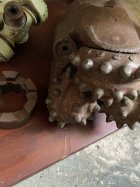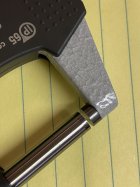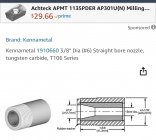Don't confuse "show" chrome like on Harleys or your example car bumper with industrial hard chrome.Also think of chrome plating on a car bumper. Again if you don't take care of it...it will rust same as the bumper on the car as the bore of the barrel.
You are using an out of date browser. It may not display this or other websites correctly.
You should upgrade or use an alternative browser.
You should upgrade or use an alternative browser.
Barrel steel, beyond stainless
- Thread starter davidjoe
- Start date
3Sigma
Silver $$ Contributor
Excellent writeup. Substrate materials make this work, and magic coatings are just that, magic, and go poof in the night once substrate microcracking begins.High Pressure in a gun barrel means the material sees high tension, not just surface compression and wear. Crack propagation and tensile failures in the substrate (base metal under the coating) are not the friend of very hard materials. Some diamond like surfaces are very abrasive instead of being low friction depending on the environment. Most are produced by methods that don't lend themselves to producing any shape or surface at will. ID coatings are not the same difficulty as OD coatings as a result.
Another point to your comment above... I cringe anytime I hear someone recommend hard brittle material for a barrel. Brittle crack propagation and fracture are not kind to brittle hard materials undergoing high pressure cycles (tension and shear load).
I’ve been away at sea. We tip high stress areas (and even low stress wear points such as a micrometer that need to remain precisely the same) so commonly, with some form of carbide.
I’m sure other shooters have pondered the same, as it’s been feasible from inexpensive circular and chain saw blades to expensive dozer “bulls” and mid-cost rock bits, that withstand intense abuse.

carbide

It makes me wonder what a short, simple but precisely ground press fit “tube” of that material, where our barrels erode, would do. (We do tend to credit long necks for preserving throats but they are not much longer, and they tend to split.
The bullet would hit the rifling faster (gain twist, optimize length, diameter and angle of lead) but if the jacket survived, and it should, peak pressure would actually be lower, good for brass, and similar to the theory behind Weatherby magnums. I suspect rifling wears linearly but on a comparatively mild slope, with the speed of engaging the bullet, but the “softer” steel’s distance from the gas jet, pressure and heat wearing it away and trying to cyclically “widen” it, on a much steeper slope, would be the benefit sought.

It’s definitely some additional work, but absolutely easier than rifling any length of the stuff, no indexing, and relatively straight forward compared to the reinforcement of aluminum rifle actions with a number of hardened steel parts.
I’m sure other shooters have pondered the same, as it’s been feasible from inexpensive circular and chain saw blades to expensive dozer “bulls” and mid-cost rock bits, that withstand intense abuse.

carbide

It makes me wonder what a short, simple but precisely ground press fit “tube” of that material, where our barrels erode, would do. (We do tend to credit long necks for preserving throats but they are not much longer, and they tend to split.
The bullet would hit the rifling faster (gain twist, optimize length, diameter and angle of lead) but if the jacket survived, and it should, peak pressure would actually be lower, good for brass, and similar to the theory behind Weatherby magnums. I suspect rifling wears linearly but on a comparatively mild slope, with the speed of engaging the bullet, but the “softer” steel’s distance from the gas jet, pressure and heat wearing it away and trying to cyclically “widen” it, on a much steeper slope, would be the benefit sought.

It’s definitely some additional work, but absolutely easier than rifling any length of the stuff, no indexing, and relatively straight forward compared to the reinforcement of aluminum rifle actions with a number of hardened steel parts.
Last edited:
There are examples of this concept (using a different material insert for the throat) in heavy weapon gun barrels, but they are not carbide. Not cheap to do and much more expensive than making them from a single material.
I can imagine the cost would spike, quickly. I’m not sure what material they do use, but if tough enough to be significantly beneficial, accelerated wear on tools to produce that final form seems inevitable, even if by EDM.
BOLTED
Silver $$ Contributor
I watched the sectioning out of a particular submarine and haul it off in covered vehicles to go to a special super secret warehouse. I was told that the ingredients used to make the steel was something they could no longer produce, was too expensive to just scrap or was rare enough to be saved so they could use it again on another project that required it. I always wondered what was so special about it. The other subs slated for decommission went to the usual scrap metal stations.
The history of metallurgy is fascinating to me. I always wondered what Japanese sword makers could have come up with if they made barrels rather than swords.
The history of metallurgy is fascinating to me. I always wondered what Japanese sword makers could have come up with if they made barrels rather than swords.
3Sigma
Silver $$ Contributor
Likely low background steel. Steel made prior to the first nuclear bombs has low background radiation that is beneficial to instruments and resisting detection.I watched the sectioning out of a particular submarine and haul it off in covered vehicles to go to a special super secret warehouse. I was told that the ingredients used to make the steel was something they could no longer produce, was too expensive to just scrap or was rare enough to be saved so they could use it again on another project that required it. I always wondered what was so special about it. The other subs slated for decommission went to the usual scrap metal stations.
The history of metallurgy is fascinating to me. I always wondered what Japanese sword makers could have come up with if they made barrels rather than swords.
You can't make any more, so it is a fixed quantity. Highly sought-after and valuable.
Quite possibly. For a while, Scapa Flow (where the German High Seas Fleet scuttled itself after WWI) was a very valuable steel mine, effectively.Likely low background steel. Steel made prior to the first nuclear bombs has low background radiation that is beneficial to instruments and resisting detection.
You can't make any more, so it is a fixed quantity. Highly sought-after and valuable.
From what I've heard though, in the years since the implementation of the Atmospheric Test Ban Treaty the amount of fallout in steel (and other materials) has fallen steadily, to where new steel from new ore is barely above bkg.
No I don't but they are similar.Don't confuse "show" chrome like on Harleys or your example car bumper with industrial hard chrome.
Just a few years back a manufacturer had to replace over a couple hundred barrels because of adhesion problems with the hard chrome plating in the bores. The hard chrome plating was flaking/peeling out with in just a couple hundred rounds.
So again it's a variable that can cause issues on different levels.
Later, Frank
I'm working with this company...
Www.b4ctechnologies.com
Their Blaze treatment was in direct response to the DoD phasing out hex Chrome.
13x more durable than nitriding. More abrasion resistant than stellite. Takes on the heat properties of the substrate up to 3400F. Ductility remains with the substrate.
Www.b4ctechnologies.com
Their Blaze treatment was in direct response to the DoD phasing out hex Chrome.
13x more durable than nitriding. More abrasion resistant than stellite. Takes on the heat properties of the substrate up to 3400F. Ductility remains with the substrate.
A really big deal here in regards to this subject is accuracy - is there any serious shooter here that would take even a 20% decrease in accuracy, even if it was with a miracle substance / treatment that gave 10x the barrel life?
I'm talking about competitive rifles, and quasi competition rifles (people who may not actually compete, but want that kinda performance for their own pleasure - prob lots more of those people than many people think)
Some miracle substance that takes forever to wear away might just be a real bitch to machine precisely, accurately, consistently. Its pretty impressive, at least as a layman, the tolerances held in rifle barrels by top manufacturers..... getting into the .0001 variance range for bore, groove diameters for the full length....
Our "common" barrel steels (like 4140, 416, etc), might not last forever, but their easy machining makes them very accurate....
Having said all of that, i would LOVE it if someone came up with the next quantum leap in barrel life, if it could be as accurate as the older materials..... could make some rounds that are currently considered way overbore into far more practical options..... think like a 22-284 shooting 90 grain VLDs at mid, high 3xxx FPS .... just as an example
I'm talking about competitive rifles, and quasi competition rifles (people who may not actually compete, but want that kinda performance for their own pleasure - prob lots more of those people than many people think)
Some miracle substance that takes forever to wear away might just be a real bitch to machine precisely, accurately, consistently. Its pretty impressive, at least as a layman, the tolerances held in rifle barrels by top manufacturers..... getting into the .0001 variance range for bore, groove diameters for the full length....
Our "common" barrel steels (like 4140, 416, etc), might not last forever, but their easy machining makes them very accurate....
Having said all of that, i would LOVE it if someone came up with the next quantum leap in barrel life, if it could be as accurate as the older materials..... could make some rounds that are currently considered way overbore into far more practical options..... think like a 22-284 shooting 90 grain VLDs at mid, high 3xxx FPS .... just as an example
^^^^Likely low background steel. Steel made prior to the first nuclear bombs has low background radiation that is beneficial to instruments and resisting detection.
You can't make any more, so it is a fixed quantity. Highly sought-after and valuable.
Probably the case.
4140 isn’t stainless, it’s chromoly like all the 41xx AISI series. They only difference from 4130 (tubing) 4140, and 4150 is carbon content.I’m in a materials class and my uncle is an engineer so maybe I can weigh in.
stainless steels like 4140, nickel chromium steels and high carbon steels are incredibly strong for their price, weight and can be machined easily they are also very weather resistant. My professor said that more chromium adds more weather resistance. Nickel, carbon and a few other elements add durability.
issues like in Vietnam when barrels were rusting out was because they weren’t chrome lined. Army probably went cheap with their steel and extra cheap with no lining. I’m not sure if modern barrels are lined or not.
A softer rust resistant metal like aluminum is a No go for a barrel. I believe that the metal will start to flex, budge and crack as a 60,000 psi round is probably pushing the elastic region on that metal quite a bit.
Edit: one thing I forgot to add was that tool steels like HSS and tungsten carbide will not make a cost efficient barrel. It will be probably $10,000+. My uncle said that titanium can become brittle, potentially enduce faster fire cracking in a bore. Titanium also likes to work harden unless special coolant and constant feed rates are being used. Then you’ll have to rifle it with what? A HSS button? That’s not gonna work, the barrel will eat that button for breakfast.
Sorry if this sound like a rant, I’ve been thinking about barrel steels a lot recently too.
jackieschmidt
Gold $$ Contributor
I can tell you a true story about Blackstar.Where did I put my Blackstar barrels? Does anybody remember those?
Joe
years ago when we used to shoot Registered 100/200 yard Benchrest Matches at The American Shooting Center on the west side of Houston, the Blackstar bunch showed up with a tent, a trailer, and a young shooter who was going to beat everybody.
To hear them talk, the actual shooting was just going to be a formality, their barrels gave them that much of an advantage .
well, it didn’t take long for reality to set in, and if I remember correctly, they packed up everything and left just after the first yardage.
I am trying to remember the name of the guy that was their sales person/promoter, He really laid it on thick talking about some type of micro polishing they did on the Lothar Waltham barrels they were using. They even published a special procedure for reaming chambers. I never knew exactly what their steel was, but I suspected it was some type of precipitation hardenning stainless similar to 15-5 PH
Butch Lambert remembers all of this. Maybe he can remember that guy’s name
Interesting summary information available on their site. I've searched for patent information, without success to-date. Interested in the 'how' with respect to surface conversion.I'm working with this company...
Www.b4ctechnologies.com
Their Blaze treatment was in direct response to the DoD phasing out hex Chrome.
13x more durable than nitriding. More abrasion resistant than stellite. Takes on the heat properties of the substrate up to 3400F. Ductility remains with the substrate.
I'd try Inconel, used in extreme heat applications, cooling tower bolts in nuclear reactors, jet aircraft breaks...it also eats tungsten carbide tooling for lunch, hard to machine...and then brittle tungsten carbide, drop it it shatters but it can take heat.
Barrel erosion would be mostly high pressure, high heat gas, pushing the bullet, not so much the bullet. So lower the pressure and heat time curve increase the barrel life. Shoot a 22 LR, or 300 blackout 11 or 15 grains of powder 240 gr MK as your long range gun but keep the pressure low, you'll get many thousands of rds of barrel life. But everyone wants super performance, which always comes at a cost...the higher the performance tbe higher the cost. So for now, I just buy another barrel ... The 308 is actually good on the barrel life to performance ratio, and I'd recommend it for new shooters and noncompetitors in these "shortage times", cause you can still find something to shoot...but everyone hates it as there are much faster race cars on the ballistic charts, and they don't want to be left in the ballistics dust, convinced the better cartridge will make them better shooters. It all comes down to how much performance are you willing to pay for...until the magic barrel material comes along, or no heat powder as an energy source, you're stuck with what's available, and physics.
Barrel erosion would be mostly high pressure, high heat gas, pushing the bullet, not so much the bullet. So lower the pressure and heat time curve increase the barrel life. Shoot a 22 LR, or 300 blackout 11 or 15 grains of powder 240 gr MK as your long range gun but keep the pressure low, you'll get many thousands of rds of barrel life. But everyone wants super performance, which always comes at a cost...the higher the performance tbe higher the cost. So for now, I just buy another barrel ... The 308 is actually good on the barrel life to performance ratio, and I'd recommend it for new shooters and noncompetitors in these "shortage times", cause you can still find something to shoot...but everyone hates it as there are much faster race cars on the ballistic charts, and they don't want to be left in the ballistics dust, convinced the better cartridge will make them better shooters. It all comes down to how much performance are you willing to pay for...until the magic barrel material comes along, or no heat powder as an energy source, you're stuck with what's available, and physics.
I have been watching and reading some on tests of tungsten carbide. The wear resistance is phenomenal and YouTube says tungsten is the most refractory of metals.
I wonder what a simple, smooth, bore diameter tungsten carbide sleeve insert for maybe an inch or more, where throats burn out, and then, after it, a 1 degree ramped engagement to rifle would do to bullet jackets.
This Amazon nozzle is not a picture of what I’m wondering about, but merely an indication of the applications it can be used for.

I wonder what a simple, smooth, bore diameter tungsten carbide sleeve insert for maybe an inch or more, where throats burn out, and then, after it, a 1 degree ramped engagement to rifle would do to bullet jackets.
This Amazon nozzle is not a picture of what I’m wondering about, but merely an indication of the applications it can be used for.

Tungsten has a very high melting temp. HOWEVER, it is hard and thus brittle. Please do not chamber a tungsten blank.
We want a tough metal not a hard metal.
It’s brittle alright, tungsten carbide. I had put a 10 mm carbide ring in my pocket, hours later pulled out keys that let it fall and hit concrete. Now there are two halves.
I’m curious how rock bit inserts and other similar applications stay in one piece.
Tungsten “alloy” seems extremely tough.
Last edited:
Similar threads
- Replies
- 66
- Views
- 10,500
- Replies
- 13
- Views
- 4,686
- Replies
- 47
- Views
- 5,792
Upgrades & Donations
This Forum's expenses are primarily paid by member contributions. You can upgrade your Forum membership in seconds. Gold and Silver members get unlimited FREE classifieds for one year. Gold members can upload custom avatars.

Click Upgrade Membership Button ABOVE to get Gold or Silver Status.
You can also donate any amount, large or small, with the button below. Include your Forum Name in the PayPal Notes field.
To DONATE by CHECK, or make a recurring donation, CLICK HERE to learn how.

Click Upgrade Membership Button ABOVE to get Gold or Silver Status.
You can also donate any amount, large or small, with the button below. Include your Forum Name in the PayPal Notes field.
To DONATE by CHECK, or make a recurring donation, CLICK HERE to learn how.









